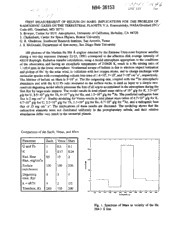
NASA Technical Reports Server (NTRS) 19940031646: First measurement of helium on Mars: Implications for the problem of radiogenic gases on the terrestrial planets PDF
Preview NASA Technical Reports Server (NTRS) 19940031646: First measurement of helium on Mars: Implications for the problem of radiogenic gases on the terrestrial planets
• +/ , N94-36153 Lvsc+ux 7+9 ..J* • / % / , / r FIRST MEASUREMENT OF HELIUM ON MARS: IMPLICATIONS FOR THE PROBLEM OF RADIOGENIC GASES ON TIlE TERRESTRIAL PLANETS; V.A. Krasnopolsky, NASA/Goddard SFC( Code 693, Greenbelt, MD 20771 S. Bowyer, Center for EUV Astrophysics, University of California, Berkeley, CA 94720 S. Chakrabarti, Center for Space Physics, Boston University G. R. Gladstone, Southwest Research Institute, San Antonio, Texas J. S. McDonald, Department of Astronomy, San Diego State University 108 photons of the Martian He 584 ]k airglow detected by the Extreme Ultraviolet Explorer satellite during a two-day exposure (January 22-23, 1993) correspond to the effective disk average intensity of 43+10 Rayleigh. Radiative transfer calculations, using a model atmosphere appropriate to the conditions of the observation and having an exosphedc temperature of 210-&20 K, result in a He mixing ratio of 1.l:L-0.4 ppm in the lower atmosphere. Nonthermal escape of helium is due to electron impact ionization and pickup of He÷by the solar wind, to collisions with hot oxygen atoms, and to charge exchange with molecular species with corresponding column loss rates of 1.4_ 105, 3_104,and 7× 10_cma st, respectively. The lifetime of helium on Mars is 5×10 +yr. The He outgassing rate, coupled with the `oAr atmospheric abundance and with the K:U:Th ratio measured in the surface rocks, is used as input to a simple two- reservoir degassing model which presumes the loss of all argon accumulated in the atmosphere during the In-st Byr by large-scale impacts. The model results in total planet mass ratios of 104 gig for K, 2.3 ,,10.9 gig for U, 8.5,, 10.9g/g for Th, 4× 10_°g/g for He, and 1.5_ 10.9 g/g for '°Ar. The predicted radiogenic heat flux is 2 erg cma s_. Similar modeling for Venus results in total planet mass ratios of 4.7,, 10s g/g for K, 6.7×10.9 g/g for U, 2.2×10 -8g/g for Th, 1.3,,10.9 g/g for He, 6.7,,10 .9gig for +oAr, and a radiogenic heat flux of 15 erg cm2 s_. The implications of these results are discussed. The modeling shows that the radioactive elements were not distributed uniformly in the protoplanetary nebula, and their relative abundances differ very much in the terrestrial planets. Comparison of the Earth, Venus, and Mars Parameter IEarth [VenuslMars t'''l'''l'''l'''l'''l'''l'''l'''l'' 'I'''I'''I'''I'''I'' U and Th 1 0.3 0.1 K I 0.17 0.04 Rad. Heat 63 15 2 Flux, erg/cm2/s = Surface 100 100 250 enrichment so Degassing 9 5 5 time, Byr o k = aR:/x 1. 2 1_ T(surface, K) 280 730 200 -SO ..l,,,l,.,l,,,l,,.l,,,l,,,l,,,l,,,l,,,l,,,l,,,l,,,l. 5"_ 5?4 574 57J $150 _2 684 _ S_ 6eO 5D2 5O4 5N IIJ,'¢IPI.I_I+IG'rH(A) Fig. 1. Spectrum of Mars in vicinity of the He 584.3 A,line 750 FIRST MEASUREMENTOF HELIUM ON MARS: Bowyer S. et al. Temperature (K) ioo lEO 14o 16o IOa 2oo 22o 2qo 240!/'''1'' _''''1'''' I'' '' I''''1' '''11''''1'''', ''''1''''1''''_ _ lao _ T Fig. 2. The Mars model t60 atmosphere appropriate to the conditions of the EUVE 140 - He observation ,i,i I ,_,5t5',, 6 Lo| Oenslty (era-_) Mars lie 5114 _t Disk Profiles 6O .... I .... I .... i _+--. , I .... i .... Effeetive Disk Average 5O T. =190K. I ppm lie - 36.2 It !, T.-210 K. I ppm fie - .'19.3 II 40 ..... 1".=2}0 K. I ppm lie - 42.4 R Fig. 3. The calculated He 584 ,_ brightness profiles across the mid- += c 30 section of Mars for throe models -r of the atmosphere with To. = 190 aa K, 210 K, and 230 K 2O // I', '°iii/ ,,i !/ ? 0 "_,__I__LL--t.--_J L _. J ' I ) ' ' _ I + J ' ' I.' :-- -1.5 - 1.0 -0+5 0+0 h.5 t.l'l I,._ l,t/ It,+ 10 ''''I''''I''''I''''I''''I''''I'''-'I ''''I'''' I'''' MARS Ar (Inlerlor) o " +"'+'_T----- / t / ff / _ tie (Interior)/5 __ Fig. 4. Abundances of +He in the /- .J interior and +°Ar in the atmosphere and the interior of Mars during its history •" / Ar (itmosphere) / / // J ,'/ f// /'// _ s i is 2 25 3 3,', ,i 45 TIM_':(lly+)
